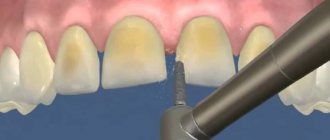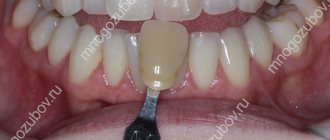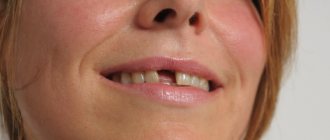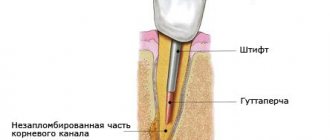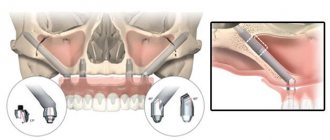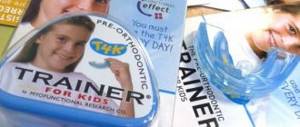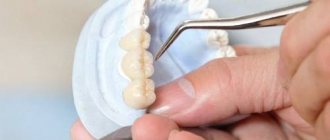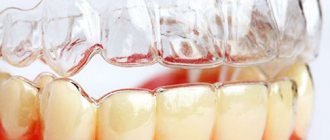There are two types of veneers:
- Composite veneers . They are made in the clinic from light-curing materials, which are more durable and have better aesthetic characteristics compared to conventional composite fillings. Installation of composite veneers is also called artistic dental restoration. Composite veneers cover the entire surface of the tooth. They are made using the so-called “direct method”, that is, directly on the teeth in the dentist’s office. The type of material and shade are selected depending on the clinical case and the color of adjacent teeth. Artistic restoration is carried out by a dentist-therapist; it has fairly high aesthetic values, but is significantly inferior in strength (service life is about 5 years) to ceramic products. Composite veneers can sometimes be installed without tooth preparation.
- Ceramic veneers (laminates) . These are thin plates made of special porcelain to replace the top layer of a dental crown. The thickness of laminates is usually no more than 1.5 mm. They can be made of solid ceramic or reinforced with a frame made of zirconium dioxide or aluminum oxide. Such veneers are highly durable, but in this case, due to the frame, they will have greater thickness than all-ceramic veneers, and therefore require significant tooth preparation.
In most cases, it is impossible to install a classic ceramic veneer without grinding, but modern technologies have made it possible to produce thinner veneers - lumineers and ultraneers. Their installation most often does not require grinding of the dental crown; minimal pre-treatment is carried out without anesthesia.
The choice of design in each case depends on the clinical case, because if the teeth are significantly curved, the color is too dark, or the need to restore only one tooth and not the entire smile area, the optimal solution will still be veneers, and not ultraneers or lumineers. To choose the method of dental restoration that is most suitable for you, consult an orthopedic dentist.
Features of preparing teeth for veneers - why turning is needed
To understand why dentists grind – or rather, prepare or grind – teeth for veneers, you need to imagine this thin ceramic plate visually (see photo below).
Is it possible to install veneers without grinding? If you install a microprosthesis on an unprepared tooth, this can lead to a number of problems. Therefore, the dentist needs to take into account all the features of enamel preparation before taking impressions or fixing an already made veneer. They are as follows:
- for high-quality and durable adhesion of the microprosthesis to the enamel, it must have grooves and roughness: the overlays do not stick well to smooth enamel and do not last long,
- the plate must fit tightly to the enamel on all sides, without an overhanging edge at the gum: otherwise food will become clogged in that gap, the adhesive composition will be destroyed (what glues the veneer to the tooth), gingivitis, local periodontitis and/or caries may begin,
- a small ledge should be created at the border with the gum on the enamel for an ideal fit of the plate,
- if the teeth are close to each other, then when installing a veneer without grinding the tooth, the restoration will stick out from the entire row: such a smile may look as if chewing gum pads were glued to the teeth,
- If you place a very thin and translucent veneer on an unground tooth that has defects (stains, very dark enamel), then the restoration will not look aesthetically pleasing: the stains will be visible, so for such patients it is better to choose thicker onlays, which cannot be placed without strong preparation.
REPROSTHETICS WITH ACRYLIC PROSTHETICS - RUB 200,000.
Re-prosthetics with an acrylic bridge on a metal frame (all included) up to 12 units.
Save RUR 30,000. Call now or request a call
“The prosthetist told me that if I want veneers, then I need to get ready to grind my teeth. Otherwise, the plates will stick very poorly and will constantly fall off. I was worried about something and asked to put it on without turning. But the doctor dissuaded me (and later I understood why). Now the smile looks just perfect, I have never had one like this. And if the enamel had not been sharpened, the teeth would have seemed thicker, this is unsightly and it is immediately clear that the person has upgraded himself.”
Evgenia, review from irecommend.ru
How long will the results last?
Composite materials without turning can last from 3 to 8 years. Their rapid destruction can occur due to injury, contact with hard objects on the teeth during a meal, and other types of mechanical impact.
If the recommendations are not followed, after a short period of time the material fixing the prosthesis may lose its strength and the plate will come off. In this case, you can simply contact a specialist, he will return everything to its place and securely fix the plate again.
Advantages and disadvantages of preparation
The advantages of grinding off part of the enamel before prosthetics are that with its help several goals will be achieved at once:
- perfect fit of the record,
- perfect smile aesthetics,
- eliminating the risk of various dental diseases,
- high-quality adhesion between artificial microprosthesis and natural fabrics (for a long service life).
The need for grinding does not mean that the dentist will dissect a large volume of tissue at once, because now there are innovative materials and methods of fixing them, for which the enamel is ground minimally (more on these varieties a little later).
Also, some patients are afraid that their tooth will be ground down too much - like for a crown. Although in most cases this should not be the case, this may already be a mistake by the prosthodontist. Therefore, before transforming your smile, be sure to ask the doctor for a portfolio of work and do not hesitate to ask the question - why are the teeth sharpened in the photo? You need to understand that veneers are placed within the enamel, the thickness of which is only 2 mm. On dentin (which is located under the enamel) the onlays are less easily attached. If a person has generally very weak enamel, or has large chips or fillings, then it is more rational to use crowns for prosthetics. And any experienced dentist will openly say this.
Nanoneers - what are they?
Nanoneers or nanoveneers are ordinary veneers that are created from a material with the addition of nanoparticles, due to which standard ceramics acquires different properties. Nanoneers are also created in Russian laboratories, but from materials and technology developed in Switzerland. As a rule, to fix nanoveneers, preparation of tooth enamel is not required, however, after installing them on the crown, the product is thoroughly polished and adjusted to the size of the tooth.
It should be noted that well-known manufacturers of ceramics for the manufacture of veneers are constantly improving technologies and adding particles to the ceramic mass that improve the mechanical and aesthetic properties of this type of microprosthesis. In particular, both e.max technology and feldspathic technology have their own similar secrets.
Indications and contraindications for turning
The indication for enamel preparation is the installation of veneers as such. It has already been said above why turning is needed. The veneers themselves are indicated for installation in the following cases:
- low smile aesthetics: presence of stains, enamel not lightened by pastes and office whitening, small chips,
- increased abrasion of enamel,
- minor bite pathologies, curvature,
- enamel hypoplasia (thinning),
- increased sensitivity of teeth,
- the patient’s desire to change the color and shape of the natural crowns of incisors and canines.
The following situations are called contraindications, or rather the absence of the need to prepare tissue for veneers:
- there are gaps between the teeth on which ceramic onlays are planned to be placed (trema and diastema),
- the plates are extremely thin: about 0.1-0.2 mm thick,
- The patient had previously had veneers: i.e. The enamel has already been ground, and now it needs to be sanded a little.
Also, you should not prepare enamel if the patient has contraindications to prosthetics - inflammation of the gums, tooth mobility, bruxism, hypertonicity of the masticatory muscles, intolerance to anesthetics. Of course, grinding is not painful, but to reduce discomfort or in case of hypersensitivity, the doctor can give a “freezing” injection or apply an anesthetic gel.
Rating
Composite is a special material that dentists use to fill teeth. It is this material that is used in the production of veneers.
Estelite
This is a universal submicrophilic composite from the Japanese company Tokuyama Dental. The size of the composite particles is the same, which ensures uniform distribution in the organic matrix, allowing for maximum fullness of the composite.
This material has a paste-like consistency that can imitate the effect of a chameleon, which makes it possible to eliminate mistakes when choosing a shade. The company offers 18 shades of composite material. The material is quickly and easily modeled and does not change shade under the influence of photopolymerization.
The composite is available in a set of 6 syringes for maximum convenient use. The average price of a set varies from 3,500 rubles.
DentalGroup – NanoPaq
This is a set of reflective composite, which includes a composite of varying degrees of transparency, allowing for high-quality and almost invisible dental restoration. The composite is quite easy to use and has excellent physical properties.
The composite contains tiny radiopaque glass filler molecules. Reliable communication between nanoparticles helps optimize physical performance. Different particle sizes make it easy to shape the composite into any shape. Colored pigments create a good, highly aesthetic effect.
The set includes 4 syringes with composite of different levels of transparency. The average cost of a set is from 6,000 rubles.
Opak-Universal
This is a universal composite material that allows a specialist to carry out high-quality dental restoration. Thanks to the use of nanotechnology in production, the composite does not discolor and does not allow dyes to pass through. Resistant to coffee and beet pigments.
The surface of the material after hardening resists abrasion, is resistant to scratches, and is perfectly polished to a shine. Ceramic particles with a diameter of up to 20 nm are used as a filler, due to which the density of the material is significantly increased.
This composite is presented in 4 shade options, which are marked with the letters A, B, C and D. The most popular shade is considered to be A, it is closest to the natural shade of the teeth.
Universal composite is available in the form of a paste enclosed in a syringe. Volume 4 g. Average price 1200 rub.
GC GRADIA
It is a light-cured microceramic hybrid composite material. Designed to carry out high-quality restoration work to restore the dentition. The composite has high mechanical strength, wear resistance, is compatible with antagonist teeth, allows for layer-by-layer modeling, and excellent polishability.
The kit includes all the materials necessary for restoration: a syringe with composite paste, a separator, a hardener, a polishing agent, an insulating liquid, 2 primers - for composite and metal, and a host of related tools. Set price from 100,000 rub.
Herculite XRV Ultra
This is a universal nanohybrid composite created on the basis of the unique HerculiteXRV technology, which has been successful on the market for more than 3 decades. The composite of this manufacturer is characterized by high strength, which plays a significant role in chewing restoration and aesthetics in frontal restoration.
The composite contains 3 fillers: polymerized, silicon and barium glass particles. Due to this combination, the composite is able to withstand maximum loads, is characterized by high polymerity, and provides easy polishability. A small set of composite material can be purchased for 5,000 rubles.
Premise
Light-curable dental composite material. It is used for tooth restoration using the direct method. The composite contains 3 types of filler, which is why it is called a trimodal nanocomposite. It is thanks to this composition that Premis is highly polished, has high strength, and has reduced polymerization shrinkage.
The composite is sold packaged in syringes or unit doses. The average cost of Premise sets is from 6,000 rubles.
Filtek Z 250
It is a light-curing microhybrid composite with good radiopacity. Created by the world famous manufacturer of products for dental reconstruction 3MESPE.
Thanks to the use of the latest developments, it was possible to introduce unique nanomolecules and nanoclusters into the composition, due to which the composite became as strong as possible. This composite is available in a wide range of shades, which allows it to be widely used for the restoration of anterior and posterior teeth.
The reconstruction material is packaged in syringes and disposable capsules. The average cost of a set of 8 syringes is 22,000 rubles.
Spectrum TPH
This is a universal composite system that is easy to use. This microhybrid composite is produced by Dentsply. The composite is characterized by an impeccable edge fit, reliability, and has excellent aesthetic qualities. The composition of the composite includes the smallest molecules, due to which it can be used for the restoration of anterior and chewing teeth.
The composite is produced in syringes and dosed compules. The average price of 1 syringe is about 1,700 rubles.
Quixfil
This is a dental restorative material created on the basis of composite resin. It was developed specifically for the restoration of teeth that bear the maximum chewing load.
With its help, the work of a specialist is greatly facilitated and accelerated, while this does not in any way affect efficiency and safety. This composite used the latest filler technology, which made it possible to ensure increased filler content. This feature significantly reduced shrinkage and polymerization time.
The composite is sold in sets of 20 compules of a universal shade. The average cost of a set varies from 2500 rubles.
ArdeFine Q
It is a universal color composite material with an enhanced chameleon effect. This is a light-curing dental filling composite intended for filling teeth and creating veneers for teeth with high chewing load.
Thanks to the use of new technologies and nano-fillers, the composite creates the basis for full polymerization and slight shrinkage. The material is perfectly polished to maximum shine. The enhanced chameleon effect helps improve color adaptation at the filling-tooth boundaries.
The composite is sold in small syringes of 4 g, the average price is from 1000 rubles.
Which veneers are placed with minimal grinding?
The depth of enamel preparation depends on how thin the ceramic onlays are made, as well as on the method of smile restoration itself. Let us further consider situations when turning will be minimal.
Direct restorations
Composite veneers without turning can be placed if the restoration is carried out using the direct method, i.e. directly in the patient's mouth. The liquid composite composition is an analogue of a filling material; it is applied layer by layer to the surface of the tooth (slightly polished in advance) and illuminated with a “blue” lamp. The result looks very natural. However, the density and strength of such compositions is less than that of classic ceramic onlays, which are made in the laboratory. That is, over time, direct restorations will begin to darken from food dyes, tobacco smoke, and will fade, and their service life is like a regular filling - 3-5 years. Cost from 7000 rubles.
Ultraneers or E.max
“E.Max” plates are made of durable and aesthetic ceramics based on lithium disilicate. Production is carried out on a high-precision milling machine, which allows you to create microprostheses with a thickness of only 0.3 mm. Because of this thinness, the E.max onlays from Ivoclar Vivadent are called “ultraneers”. Very little enamel preparation is required for them. The service life is 10-15 years, and the cost starts from 28 thousand rubles.
Microprostheses made of zirconium dioxide
Zirconium dioxide veneers are the strongest and most durable. For comparison, the strength of ordinary porcelain (classical ceramics) is 60-80 MPa, and for zirconium dioxide this figure exceeds 1200 MPa. This makes it possible to produce zirconium dioxide plates only on a milling machine, which increases the price of prosthetics, but makes the structures very thin and ideally adjacent to the teeth. On average, the thickness of the finished overlay is 0.4-0.6 mm, since the material itself is very white, i.e. A layer of aesthetic ceramics will be applied on top of the turned product - this slightly increases the thickness. The service life of such veneers is about 20-25 years, and the cost starts from 35 thousand rubles.
Read more about the advantages and disadvantages of zirconia veneers.
Are there veneers that are placed without turning?
Installation of veneers without turning is also possible. This refers specifically to laboratory microprostheses made of ceramic materials. For example, these could be lumineers - both individual Cerinate and template DUO-PCH. Both varieties are manufactured only in the USA at the plant of the company that developed Lumineers, and the only one that has the right to manufacture them (the patent is not sold to anyone). Lumineers are the thinnest currently known products (thickness is about 0.1-0.2 mm), they consist of a nanohybrid material, the composition of which is kept secret. The service life of lumineers is about 20 years. And the price, depending on whether the product is a template or an individual one, varies between 40-70 thousand rubles.
Another type of veneers that are placed almost without grinding the teeth is ceramic composite veneers. Ceramic composite is a relatively new material, very light and durable. Therefore, it receives only positive reviews from orthopedic dentists. The service life of the products is from 15 years, the cost is from 15 thousand rubles.
You need to understand that when installing any microprostheses or fillings, the doctor must first still grind the enamel so that it becomes rough for better adhesion to the adhesive.
Recommendations for selection
A specialist should select the composite material for creating veneers.
But when choosing, he should focus on the following criteria:
- High degree of radiopacity of the composite, which will be used to create veneers on teeth with the greatest load.
- Excellent compatibility with dental tissues, complete sealing of internal teeth.
- Abrasion resistance, maximum tensile and compressive strength.
- Ease of use. The material should easily fill gaps without creating problems during formation.
- Biocompatibility with dental tissues and oral cavity.
- Long service life without deterioration of material properties.
- Maximum matching of color and gloss, transparency of the material.
- Versatility.
- Availability.
Stages of prosthetics and their features
Prosthetics with aesthetic microprostheses includes the following stages:
- preparation: teeth are cleaned from stone and plaque, fillings are changed, the enamel layer is prepared,
- taking impressions: these can be either traditional impressions on impression material or digital impressions obtained by scanning the oral cavity with a 3D scanner,
- production of products in the laboratory: microprostheses can be manufactured using different methods - pressing, milling on a CAD/CAM system,
- fitting and fixation with temporary cement: this is a kind of “test drive” of a new smile, which lasts 1-2 weeks. This way a person can assess how comfortable he is and whether the designs need to be modified,
- fixation with a permanent adhesive composition.
Is it possible to restore a ground tooth after this?
Hard dental tissues, in particular enamel, do not have the ability to grow a new layer to replace the polished one. Otherwise, dentists would not put fillings, but would wait “until it heals on its own.” A ground tooth can only be restored with a new veneer or filling (direct restoration). If you refuse restoration and leave everything as is, then the remaining enamel will not look aesthetically pleasing - it will not have shine, and its protective functions (from caries, overheating and injuries) will be greatly reduced.
Author: Matyushenko M. A. (Thank you for your help in writing the article and the information provided)
